Dr. Stefano Musacchi, professor of horticulture at Washington State University and Bob Gix, horticulturist at Blue Star Orchard shared pear pruning ideas at this spring’s Young Grower pruning demonstration in Cashmere WA. Here are a few of the concepts for pruning young pear orchards Musacchi shared.
Removing large branches
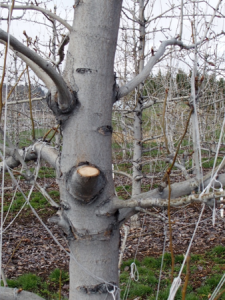
Large branches create shade in the canopy. “Instead of few large branches, I would prefer to have smaller branches,” Musacchi explained. Trees with many smaller branches can bear as much fruit as trees with few large branches without creating as much shade while increasing vigor. “We need 30% of the ambient light in order to induce flower bud formation.” Removing large branches over time helps ensure that sufficient light to produce buds and fruit reaches a larger portion of the canopy. It is critical for an ongoing renewal process. Don’t cut too many large branches. Remove one to two large branches per tree per year. Pruning which is too aggressive can result in excess tree vigor the following year.
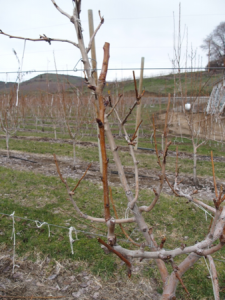
Tira Savia
Tira savia, which literally means pull sap in Spanish is a term describing a technique for invigorating branches by pruning the end of the branch. Cuts are on one-year-old shoots leaving two to three vegetative buds. This promotes new shoot growth in the external part of the limb.
This pruning technique can help to control vigor and manage shoot growth. Removing the tip also helps to break apical dominance and reduce the blind wood in the basal part of the branch. Sap flow to the area is increased. “Tira savia helps keep the secondary structure of the branch active and alive,” Musacchi stresses, “In Bartlett if the vigor is reduced by bending the branches too much the number of new flower buds will decrease.” Remember this technique should only be used on one-year-old wood. Anjou have a different pruning technique.
Minimizing blind wood
Blind wood is an area of the branch without buds. Blind wood is usually located in the basal part of the branch. Some varieties tend to produce more blind wood than others depending on their growth and bearing habit. In order to minimize blind wood (and excessive suckering) it is important to prune and train for optimum branch angles. In Bartlett the optimum branch angle is 45o. When Bartlett branches are at a flatter angle (i.e. 90o from the tree) they tend to produce blind wood. “I don’t like branches which point downwards [on Bartlett],” Musacchi explains. These branches will be weighed down with the fruit and produce blind wood. If you need to renew some branches (10% per year is recommended) select those where the tip of the branch is not higher than the point where the branch enters the tree for removal. If too many branches are not at the optimum angle consider a plan for removal where there is another branch to train in its place. Generally not all of these cuts can be made at once. Try to look forward, identify what branch should take its place, train that branch and then remove the shallow angled branch the next year.
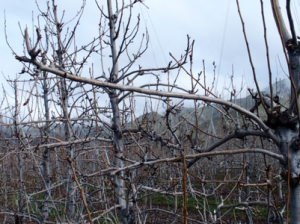
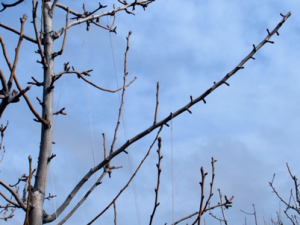
Reduce competition with the apex
When trees are young we want to reduce competition with the apex (apical dominance) in order to reach full height and fill out the canopy but at the same time have some feather production. Pears grow in a very acrotonic way and in the older trees it is important to maintain a conical shaped pear tree that will allow light to permeate the entire canopy. If we do not maintain the conic shape of the tree, we will start to form an “umbrella,” particularly on an Anjou pear tree which requires a different pruning compared to Bartlett.
Remove the shoots and branches that are competing with the axis. Musacchi recommends a cut that leaves a stub so that it will continue to produce new shoot and potentially new branches that can be used in the future. You can use the 30% rule to decide what to remove. “In the top part of the tree branches whose base is more than 30% the diameter of the trunk should be removed.
Pruning principles developed for higher density orchards are useful for traditional trees as well as smaller, higher density trees.
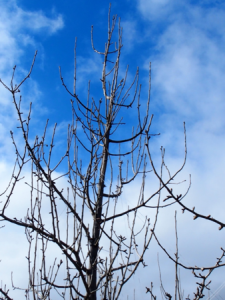
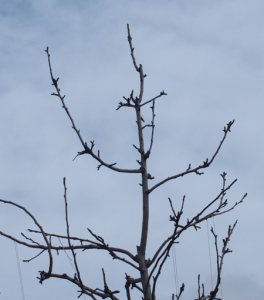
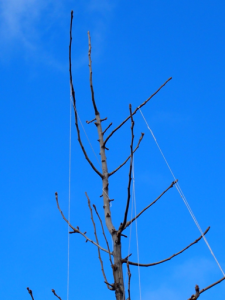
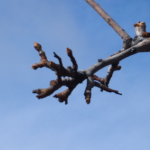 Removing clusters of older spurs
Removing clusters of older spurs
Clusters of older spurs tend to have smaller buds and produce smaller fruit. Thinning some of these “chicken leg” clusters helps optimize fruit set. Maintain spurs growing from the bottom of the branch.
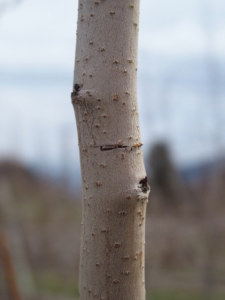
Girdling and Notching
Pear trees, like many plants, produce auxin – a plant growth hormone, in their growing meristems and shoot tips. Auxins flow down inhibiting bud break for a distance below the growing shoot tip. A shallow cut into the cambium interrupts the flow of auxins to the dormant buds and these buds will start to grow. In areas where the trees have problematic blind wood, girdling and notching can create a bud swell. The best time to girdle or notch is in late February when the sap is starting to flow.
The goal is dynamic pruning. “We need to rotate the branches to there is always good size wood and good size buds,” Dr Musacchi explains.
For detailed information on pruning pears check out Pruning Bartlett Pears to Optimize Fruit Quality https://treefruit.wsu.edu/videos/pruning-bartlett-pears-to-optimize-fruit-quality/ a video tutorial with WSU’s Dr Stefano Musacchi.
